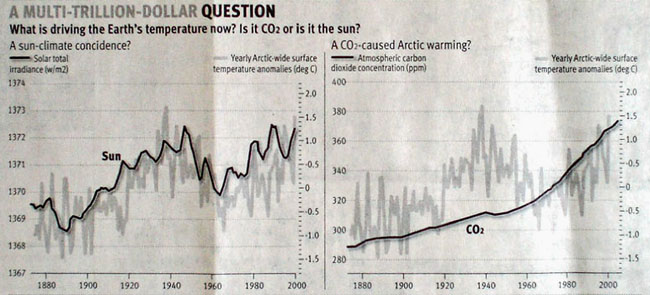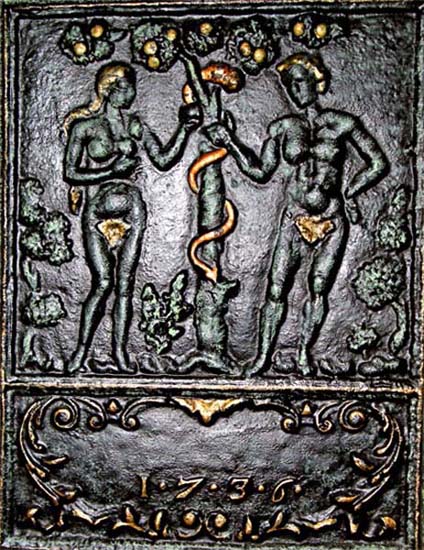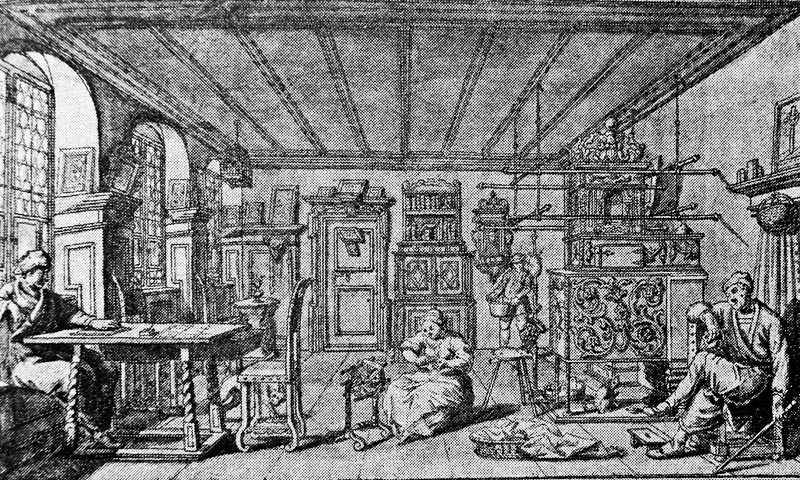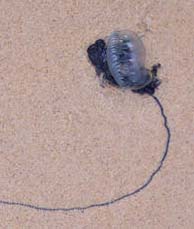|
Biographical Log of Michael Furstner - Page 128
2008 ||
2009 :
Jan |
Feb |
Mar |
Apr |
May |
Jun |
Jul |
Aug |
Sep |
Oct |
Nov |
Dec | Page :
Previous |
Next |
Most Recent -
Next -
Previous -
Page 1 -
Photos -
Index -
Topics -
MP3s -
Jazclass Links
Sunday, December 6 2009
(diary, man made climate change)
The previous two weeks or so have, almost simultaneously, seen three significant
developments which together have dramatically changed the debate and perception
on so-called man made Global Warming (mmGW). They are :
- The online exposure of thousands of emails from the Climate Research Centre
of the University of East Anglia.
- The strong criticism of leading mmGW propagandists (James Hansen, Bjorn
Lomborg and the IMF), on the usefulness of the Copenhagen summit and the value
and effectiveness of Emission Trading Schemes.
- The election of Toni Abbott as new leader of the Australian Liberal
Party and his immediate rejection in Parliament of Labour's proposed Emission
Trading Scheme bill.
1. The Emails
 The damning emails obtained by computer hackers and published online reveal that
"we now have grounds for thinking that leading researchers
tweaked results to fit their ideological preconceptions, rigged peer-review
processes and were prepared to destroy data rather than submit it to freedom-for-information processes", reports Christopher Pearson in "The Weekend
Australian" (page 7, December 5, 2009).
The damning emails obtained by computer hackers and published online reveal that
"we now have grounds for thinking that leading researchers
tweaked results to fit their ideological preconceptions, rigged peer-review
processes and were prepared to destroy data rather than submit it to freedom-for-information processes", reports Christopher Pearson in "The Weekend
Australian" (page 7, December 5, 2009).
As a consequence the Head of
the Climate Research Centre of the University of East Anglia has been stood
down while an investigation is going on. The Saudi Arabian
Government has in response to the emails retreated from any possible
international deal, stating that the emails cast serious doubt over the validity of
the man made climate change science.
It has also been reported that details and discussions about the damning
emails have been suppressed in Australia by the (reputedly left wing
influenced) Australian Broadcasting Commission (ABC). Last week a Google
search on "Climategate" brought up over 21 million results, while a search
on ABC online brought up just one single result. ABC 774 Radio also
remained totally silent about the issue.
2. New criticism on ETS
World leading climate change scientist James Hansen and also the
IMF (International Monetary Fund) have argued that an Emissions trading
scheme is fundamentally flawed and totally ineffective and instead prefer the
introduction of a straight carbon tax.
Bjorn Lomborg, Head of the Copenhagen Consensus Centre, has declared that
slamming taxes on carbon emissions is a total waste of time and instead urges
Governments to dramatically increase their funding for research on new and
cleaner energy production technologies.
3. Tony Abbot's new Leadership
Upon his election as new Liberal Party Leader, Toni Abbott immediately announced
that his party would reject Labour's ETS Bill. They did that effectively the very
next day. Abbott also stated that they would match the carbon reduction targets
set by the Rudd Government, but by means of focusing on new technologies
rather than a tax. This is in line with the proposal made by Bjorn Lomborg and
clearly way ahead of Rudd's EMS which looks like rapidly becoming a dead duck in
the water.
(Subsequently Greg Hunt, the new Liberal spokesman on climate change, stated that in due course a price on carbon might be considered, in order to fall in line with any US system inplace in 4 or 5 years time.)
I am personally very pleased that the truth finally is starting to come out.
Thousands of genuine scientists have protested, online and through petitions,
against the "so called science" of man made climate change for a number of years,
but up until now have been rejected and ridiculed by the media, (especially
socialist) politicians, and large swags of predominantly green and socialist
supporters.
Most Recent -
Next -
Previous -
Top -
Page 1 -
Photos -
Index -
Topics -
MP3s -
Jazclass Links
Monday, December 7 2009
(diary, Michel de Montaigne, Ofentafeln, Kastenofen)
 I have never been quite sure about the origin and use of those Ofentafeln I photographed last year
in Hotel Sankt Maximilian (Bernkastle-Kues, Germany). My initial idea was that they had been decorations on the doors
of old fashioned rectangular cast iron cooking stoves. But reading Alain de Botton's
book "The Consolations of Philosophy" I think I found a quite different
answer.
I have never been quite sure about the origin and use of those Ofentafeln I photographed last year
in Hotel Sankt Maximilian (Bernkastle-Kues, Germany). My initial idea was that they had been decorations on the doors
of old fashioned rectangular cast iron cooking stoves. But reading Alain de Botton's
book "The Consolations of Philosophy" I think I found a quite different
answer.
One of the French 16th Century nobleman and philosopher Michel de
Montaigne's life long wishes was to travel abroad. In the summer of 1580 he
set off on horseback (accompanied by four young noblemen and a dozen servants),
from his home in SW France (30km east of Bordeaux) to Rome, via Germany, Austria
and Switzerland. The round trip covered 4,800 kms (3,000 miles) and took 17
months to complete.
 Michel de Montaigne was in particular interested in the many differences he
observed between his native France and other countries. One striking difference
he found in Germany was the way people warmed their houses. Whereas the French
still used open fire places in their homes, the German's had developed a new way
: Kastenofen.
Michel de Montaigne was in particular interested in the many differences he
observed between his native France and other countries. One striking difference
he found in Germany was the way people warmed their houses. Whereas the French
still used open fire places in their homes, the German's had developed a new way
: Kastenofen.
"In the middle of the 15th Century", I read in Alain de Botton's book,
"in the southern German states, a new method of heating
homes had been developed : the Kastenofen, a freestanding box-shaped iron
stove made up of rectangular (cast iron) plates bolted together, in which coal or
wood could be burnt. Closed stoves could dispense four times the heat of an open
fire, yet demand less fuel. The heat was absorbed by the casting and spread
slowly and evenly through the air. Poles were fixed around the stoves for drying
laundry."
From the (above right) illustration (also taken from de Botton's book) it is clear
that the rectangular cast iron component plates of the Kastenofen are
elaborately decorated. I therefore now believe that the antique Ofentafeln seen in Germany today are the
remaining component plates of these old Kastenofen. (A Google search confirms this idea, try "Kastenofen photos")
Most Recent -
Next -
Previous -
Top -
Page 1 -
Photos -
Index -
Topics -
MP3s -
Jazclass Links
Tuesday, December 8 2009
(diary, Michel de Montaigne, the mind, emotions)
Philosophy of Happiness : 1 (Overview)
 Just uploaded my (not so silent) version of Silent Night. Hope you like it.
Just uploaded my (not so silent) version of Silent Night. Hope you like it.
The Renaissance philosopher Michel
de Montaigne (1533–1592) spent most of his days in his library on the third floor of
a cylindrical tower at one corner of his castle, 30 km east of Bordeaux. He had
about a thousand books on philosophy, poetry, history and religion, which were
arranged on semicircular shelves against the wall of the tower room.
He also had 57 short inscriptions (taken from the Bible and the Classics) painted
across the wooden beams which supported the library ceiling. One of them (by
Sophocles) was :
The happiest life is to be without
thought.
When I read this in Alain de Botton's
book "The Consolations of Philosophy" my mind immediately cast back to my Dad's
pocket diary (the popular Dutch "Success Agenda") of 1981 (the year he
died). I still have it, it includes, besides addresses, birthdays of his family,
friends and staff, etc., two pages of short sayings my Dad had collected from various sources over the years. One of them read :
The fish has the water to swim in
The bird has the air through which to fly
And man has his mind with which he is discontent . . . .
|
Why this negative view of the human mind (so contrary to most philosophers) ? I
understand and appreciate the intention above statements attempt to make,
but taken literally they are of course wrong, because they merely shoot the
messenger.
It is not the mind which causes us unhappiness or any other emotion. It are our
circumstances (using the word in its widest possible sense) which are the cause for our
emotions. The mind merely interprets the circumstance and passes it on
to trigger the appropriate emotion.
circumstance > > >
mind > > > emotion
Without a mind (assuming that the rest of our brain still functions) we would
feel no emotions at all ! We would merely live like zombies.
I am sure you have experienced proof of the above "chain reaction", but let me
give you a typical example.
 About 20 odd years ago, teaching one of my Saturday afternoon bridge
classes at my home in Glenelg (a coastal suburb of Adelaide, South Australia)
there was a middle aged man in my class who was just divorced from his
wife.
About 20 odd years ago, teaching one of my Saturday afternoon bridge
classes at my home in Glenelg (a coastal suburb of Adelaide, South Australia)
there was a middle aged man in my class who was just divorced from his
wife.
"Michael", he said at the end of one
afternoon to me "these are the only three hours of the week
that I am not in total emotional agony over my present circumstance. My mind is
so busy figuring out this wonderful game of bridge that it has no time to focus
on anything else!"
So the bottom line about changing the state of your emotions when you are unhappy,
distressed or discontent is simple : examine you current circumstance and
try to do something about that. Three common scenarios come to mind.
The first one is when there is a circumstance you can do absolutely
nothing about, a death in the family, a divorce. In such case try to find
temporary relief (like my bridge student in above example) by diverting the
mind to something totally different.
The second possibility is that your mind misinterpreted the
circumstance. For example you find your girlfriend in (what you believe to be) a far too
intimate conversation with another guy. Naturally this makes you unhappy, not to
say upset. But as you join the couple you suddenly find out that the supposed
contender is your girlfriend's brother. Immediately your emotions do a
dramatic about turn.
The third scenario is where you need to change your circumstance.
In its simplest form this may involve perhaps talking it out with someone who has
upset you with something. This almost always works.
In the ultimate
case, where the circumstance is your current life as a whole, there is
nothing but either bear it or change your life. A "sea change".
This may be relatively easy to achieve, or it may be agony,
like in my own case, where, after 15 years of regularly recurring deep
depressions in my former life as a professional geologist, I totally upended my
life and started from scratch an entirely new life in music. It was very painful,
especially for those so dear to me, and it was not easy, but it cured my
depressions and unhappiness forever!
Philosophy of Happiness continues on December 11
Most Recent -
Next -
Previous -
Top -
Page 1 -
Photos -
Index -
Topics -
MP3s -
Jazclass Links
Wednesday & Thursday, December 9 & 10 2009
(diary)
 There have been quite a few Bluebottle jellyfish in the Mooloolaba surf, but with the middle (where I swim, marked Urunga on the map) and Eastern most end of the beach largely spared of this nuissance. Today however, with a strong Northerly sea breeze blowing, the Bluebottles have been pushed right into the fishhook shaped pocket of our beach, and it is Bluebottles galore wherever you look.
There have been quite a few Bluebottle jellyfish in the Mooloolaba surf, but with the middle (where I swim, marked Urunga on the map) and Eastern most end of the beach largely spared of this nuissance. Today however, with a strong Northerly sea breeze blowing, the Bluebottles have been pushed right into the fishhook shaped pocket of our beach, and it is Bluebottles galore wherever you look.
So "no way José" am I going to spend much time in the water today. I wade up to just over my knees into the foaming surf, then bend over and splash around a bit, enough for a refreshing cool down, then I am out again. I will try again tomorrow. If it is still bad then I may check out the extreme Eastern end of the fish hook.
These Bluebottles can have very long hair thin tails, up to a meter and a half (5 ft) in length and wrap themselves around an arm, leg or even chest and cause excruciating pain. Not deadly, but very very painful. Several swimmers have been stung these last couple of days. The Life guards always used to apply vinegar to the afected areas of skin, but now they only put ice on it. Don't understand why. Robbie, one of the employees at the Surf Club, tells me that keeping the affected area warm (rather than cold), say with a hot water bottle, is best to reduce the pain.
Comments -
Most Recent -
Next Page -
Previous -
Top -
Page 1 -
Photos -
Index -
Topics -
Jazclass Links
Copyright © 2009 Michael Furstner
|





